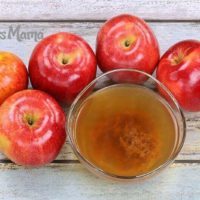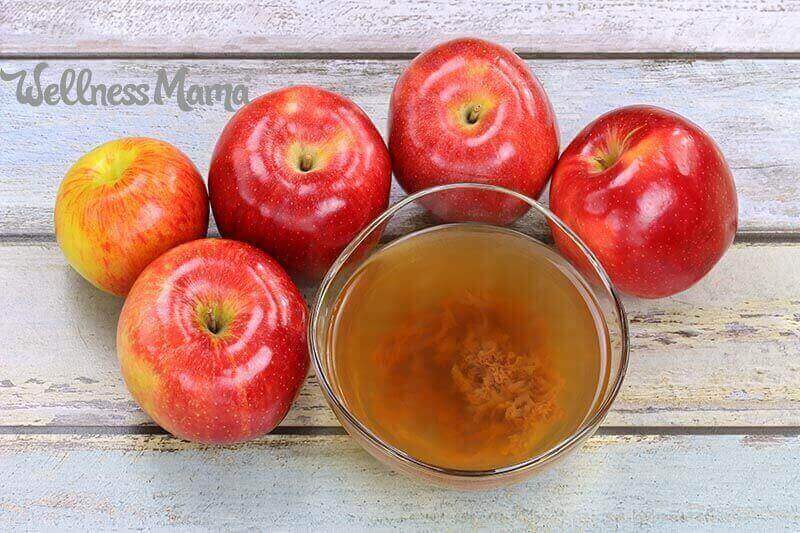Every fall we take at least one trip to an apple orchard near us. They have family-friendly activities, wonderful local canned goods for sale, and of course, apples. So many apples! My kids love applesauce so I take advantage of the apple season to make homemade applesauce so that we can enjoy it throughout the year.
Don’t Waste Apple Cores and Peels!
I don’t always peel the apples when I make applesauce but if you do take the time to peel the apples (maybe you even prefer your applesauce that way), you can use the peels and the cores to make apple cider vinegar. This way you have virtually no waste!
It is also totally possible to make apple cider vinegar from the whole apple so don’t worry if you don’t have leftover peels and cores from anything.
When I make applesauce, I typically do large quantities at a time so I have enough peels and cores for a batch of apple cider vinegar. If you only occasionally use apples, you can store the peels and cores in the freezer until you have enough gathered to start a batch.
If you don’t have an apple orchard nearby, farmers markets are another great place to get organically grown apples. Just check with the farmer. Organic apples are ideal for apple cider vinegar, especially if you will be using the peel. If you cannot find organic apples, peel them first. Discard the peel and just use the inside portion.
What Is So Special About Apple Cider Vinegar?
Apple cider vinegar (ACV) has many healthy uses. It is made through the process of fermentation and is high in phosphorus, magnesium, potassium, and calcium. Hippocrates is believed to have prescribed ACV for a variety of ailments.
ACV for Digestion and Heartburn
ACV is the base of spicy cider which is a great remedy to help quickly knock out a cold.
Amazingly, and contrary to what seems logical, ACV also has a valuable role in preventing heartburn and aiding digestion. In most cases heartburn is actually caused by too little stomach acid which slows down digestion. Food and gasses put pressure on the stomach, causing stomach contents (including stomach acid) to leak back into the esophagus. When you remedy heartburn with ACV it increases stomach acid and helps the body digest the food more quickly. This prevents the build-up and subsequent leakage which causes heartburn. You can read more about natural heartburn relief here.
ACV Topically
In addition to its many benefits when taken internally, it is wonderful for the skin. When added to bathwater, it helps to naturally restore balance to the skin’s pH. It also helps kill bacteria and fungus on the skin which can lead to a host of problems, including eczema, dandruff, and other skin conditions.
Because of its great pH balancing benefits and dandruff preventing abilities, it makes a great hair rinse that replaces conditioner and can be used after shampooing with a natural shampoo.
Unfiltered, Unpasteurized, And With “The Mother”
Most of the ACV you find in the supermarket is pasteurized and highly filtered. These versions still work well for cleaning but they are not optimal for internal and culinary uses because most of the benefits are gone once the “mother” is filtered out and the vinegar is pasteurized.
There are a few available that are “with the mother” which means they leave in the beneficial bacteria that develops during the fermentation process in the vinegar. When you make your own ACV you can be sure that your vinegar retains this beneficial “mother.”
Important Notes:
- This recipe uses sugar. The sugar is necessary to “feed” the yeast, but most (if not all) of the sugar is fermented out. People often ask if they can use honey. The short answer is yes, but it really does not work as well and causes the whole process to take longer. And to be honest, because the sugar is broken down, there really isn’t anything to be concerned about as far as the effect it will have on blood sugar.
- Make sure all of your equipment and your jar are very clean. It is important to make sure you don’t introduce any bacteria other than what is naturally occurring in the process.
- My favorite apple variety to use for applesauce is Gala so my scraps are usually a majority Gala. However, you get the best flavor if you have a mix of varieties. I use mostly Gala, but I will throw in a mixture of other types for the rest. Some I have used are Fuji, Honeycrisp, Granny Smith, and McIntosh. It just adds some complexity to the flavor.
- White scum is going to form on the top. This is normal. Mold, however, is not good and will spoil your ACV. Be sure that the apples stay submerged under the water. This will help prevent mold. You can use a fermentation weight or even just a smaller glass jar (thoroughly clean the outside) and set it on top of the apples to keep them submerged.
- Gnats and flies love ACV so you need to make sure your jar is well covered. However, it needs to be able to breath and release gasses created from the fermentation process so do not use a solid lid. Cheesecloth or a coffee filter work well.
Final Notes
At some point while making apple cider vinegar, you will probably notice a SCOBY-like “thing” that forms on the top. This is the “mother.” You can remove it or you can just leave it floating in your vinegar.
If you don’t want to make your own apple cider vinegar, it is becoming more common for grocery stores to carry organic ACV “with the mother.” Or you can buy it online.
How to Make Apple Cider Vinegar
Before starting to make ACV, there are a few things you’ll need to have on hand first:
Supplies:
- Clean jar – you can use any size jar (I have used a wide mouth quart jar and a half gallon pickle jar)
- Organic apple scraps – enough to fill your jar ¾ of the way full
- Organic cane sugar
- Filtered water
- Fermentation weight or small glass jar
- Cheesecloth or coffee filter
- Rubberband

Apple Cider Vinegar Recipe with the Mother
Servings
Ingredients
- organic apple scraps
- 2 TBSP cane sugar
- 2 cups water (filtered)
Instructions
- Clean a quart jar very well and let air dry.
- Fill the jar ¾ full with apple scraps. If you are using whole apples, roughly chop them up before you put them in the jar.
- Dissolve the cane sugar into the cup of water.
- Pour sugar water over the apples until they are completely submerged. Add a little additional water if needed to make sure the apples are covered.
- Weigh down the apples with a fermentation weight or with the small glass jar. Any apples that are exposed to the air could mold.
- Cover with the cheesecloth or coffee filter and secure with the rubber band.
- Store in a dark place at room temperature. I put mine in a cabinet in the kitchen.
- Leave it for approximately 3 weeks. Check on it every few days to make sure the apples are staying under the water and to make sure no mold is growing.
- After 3 weeks, it will still smell fairly sweet. Strain the apples pieces out and return the liquid to the jar. Compost the scraps.
- Recover and put the jar back in a dark spot for another 3-4 weeks, stirring every few days.
- When the ACV has reached the “tartness” you like you can put a lid on it or transfer it to a different jar with a lid and start using it!
Nutrition
Notes
How do you use apple cider vinegar? Will you try your hand at making your own?




Leave a Reply